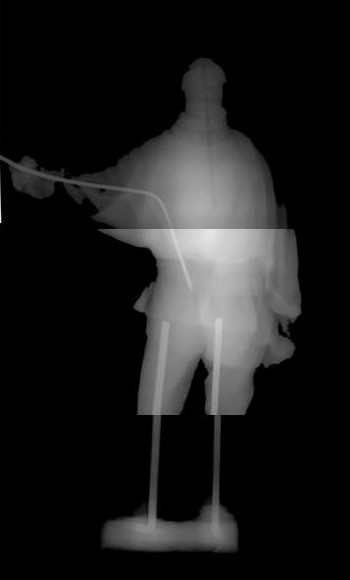In 2013 the Polar Museum was given a plaster maquette of Scott, made in 1915 by his wife, the sculptor Kathleen Scott. A maquette is a working model for a piece where the final version will be made in another, more expensive material. In this case, the plaster maquette is about 2 feet tall, and it was used as the basis for two life-sized statues of Scott, a bronze one in London and a marble one in Christchurch New Zealand.
The maquette is rather fragile and in a couple of places the surface is cracked or has popped off revealing metalwork beneath. We were keen to find out more about how much metal is inside the sculpture and what sort of condition it is in. So recently we took the maquette over to the Hamilton Kerr Institute (HKI) in Whittlesford, where they have a special X-ray set-up for examining objects and works of art.
The HKI is in an impossibly beautiful mill house surrounded by gorgeous gardens:
In this glamorous setting we set about zapping the maquette with X-rays. The whole process was ably overseen by Chris Titmuss, who specialises in imaging techniques for analysing artworks, and the lovely HKI paintings conservation students Michaela (left) and Amiel helped in capturing the images:
The sculpture was laid underneath the X-ray machine – in this picture the machine is the grey cylinder thing suspended on a frame above, and the maquette is on the floor, protected by a fully supportive rigid vacuum cushion. The X-ray film is underneath the statue where it can’t be seen:
We had to use a very powerful X-ray beam to penetrate the plaster – in fact it was so strong we had to fire the machine off remotely from two rooms away to avoid being zapped ourselves! Here is Chris next to the controls of the machine, safely away from the radiation beam:
We fired 150 kiloVolts at the sculpture for two minutes to get the images, and had to do this several times to get pictures of the whole sculpture because each film plate was smaller than the statue. When the different images were spliced together this was the result:
There are three quite thick pieces of metal in the legs and the outstretched arm (the pale bands), and they are corroding slightly at the edges in places – this is what has caused the surface to crack where the metal is quite close to the surface. The metal pieces have slightly shaped ends and look as though they were re-used from something else. Interestingly there is another support in the top half of the maquette, but this is made of wood and not metal. On the X-ray it looks like a darker grey stripe up the centre of the head and chest. In detail you can even see fine stripes where the wood grain is showing:
Seeing the supports inside the sculpture gives a better understanding of how Kathleen Scott was working when she made this image of her husband. The maquette is actually a plaster cast of an earlier model, probably made from clay. This would have been destroyed in the process of casting. The plaster cast was made in sections and the metal and wooden struts were inserted when the pieces were put together before the plaster dried. This process has to happen quickly because plaster hardens pretty fast. The slightly random selection of wood and metal scraps for the supports underlines that this was a working model and not intended as a finished piece in its own right. The final life-size versions don’t have the same energetic, free style as the maquette, which is the closest thing we have to Kathleen’s vision of her husband a short time after he died.
Sophie

 Scott Polar Research Institute
Scott Polar Research Institute





